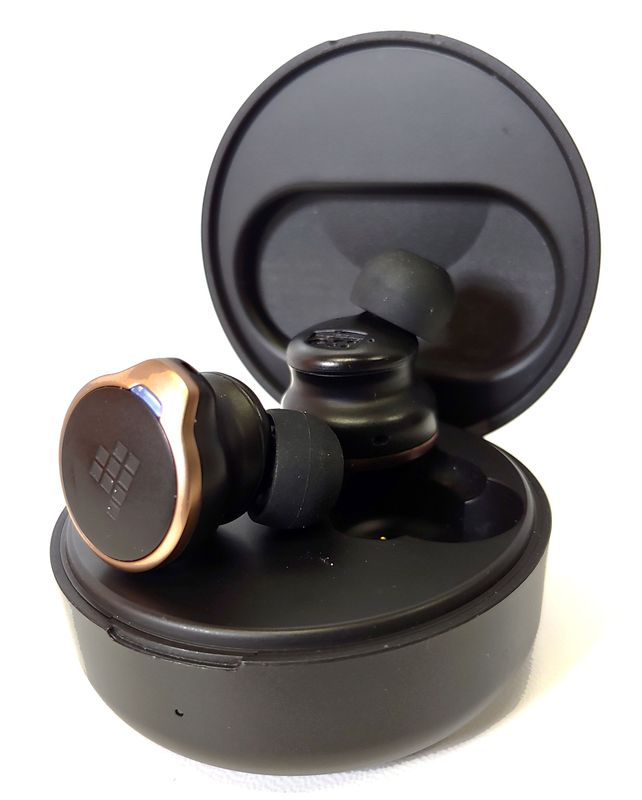
REVIEW – With each product release, the performance and technology of TWS earbuds improves as the cost for an established level of quality drops. The Tronsmart Apollo Bold TWS+ earbuds have a sound and wealth of features that are sure to be appreciated by the most discerning user. Read on to see what I think!
What is it?
The Tronsmart Apollo Bold TWS+ earbuds are the latest truly wireless stereo (TWS) model from Tronsmart, a twelve-year-old Chinese company that manufactures Bluetooth audio, power packs and adapters, peripherals, cables, and stands. The Apollo Bold TWS+ is the first product Tronsmart has made that uses a new Qualcomm chip to deliver Bluetooth 5.0 and a host of other Qualcomm audio technology, including:
- Qualcomm TrueWireless Stereo Plus technology
- Qualcomm Active Noise Cancellation (ANC) technology
- Qualcomm aptX audio technology
- Qualcomm cVc audio technology
The System-on-Chip (SoC) design also boasts minimal power consumption which allows the earbuds to be used for extended periods before recharging. Typical TWS systems require that the one earbud pair as the host with the streaming device and the other earbud pair with the host. TWS+ is a technology in which each earbud can be used independently of the other; either earbud can act as the host.
What’s in the box?
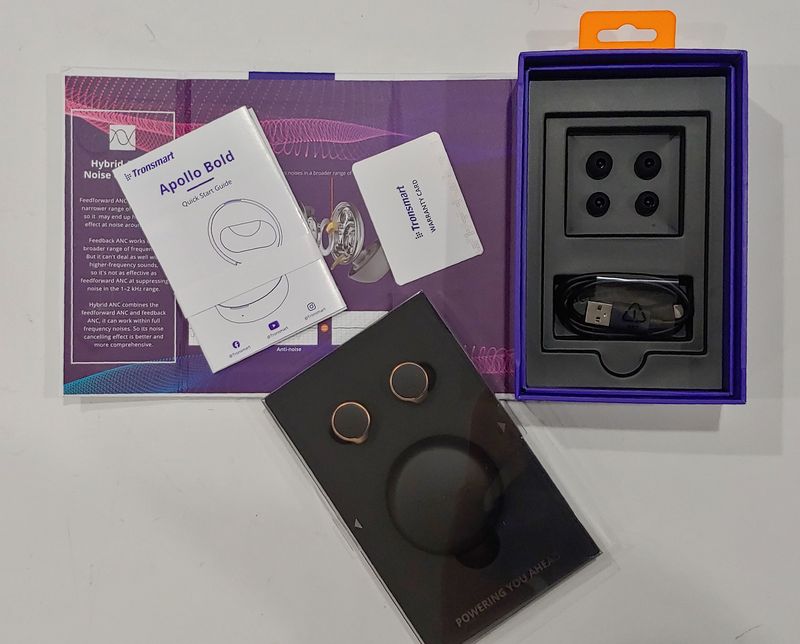
- Apollo Bold TWS+ ANC Earbuds with charging case
- Charging cable
- User manual
- Storage bag
- Warranty card
- Quick start guide
- Small, medium, and large ear tips
Hardware specs
- Technology: Qualcomm aptX audio technology, Qualcomm Active Noise Cancelling (ANC) technology, Qualcomm TrueWireless Stereo Plus, Qualcomm cVc
- TWS+ binaural synchronous transmission technology
- Intelligent in-ear detection
- Supports voice assistant
- Convenient touch control
- 360 degrees hybrid noise-canceling via 6 mics
- 35 dB full frequency active noise canceling
- Chip: Qualcomm QCC5124, supports aptX, AAC, SBC
- Bluetooth: Version 5.0
- Bluetooth Compatibility: HFP/HSP/AVRCP/A2DP
- Transmission Distance: Up to 15 meters / 50 feet
- Water Resistant: IP45
- Battery Capacity: Earphone: 85 mAh; Charging case: 500 mAh
- Play Time: Earphone: ANC On: up to 7 hours (50% volume) ANC Off: up to 10 hours (50% volume); Charging case: over 30 hours (50% volume)
- Charging Time: Earbud: 2 to 2.5 hours Charging case: 2.5 hours
- 10 mins charging for 1 hour use
- Type-C charging port
- Frequency Range: 20 – 20K Hz
- Customized graphene driver for better sound quality.
- Driver Unit: 10mm
- Impedance: 32Ω±15%
- Dimension: Earbud: 16.86 x 23.13 x 23.96 mm / 0.66 x 0.91 x 0.94 inches Charging case: 29.45 x 19.03 mm / 1.16 x 0.75 inches
- Net Weight: Earbud: about 7.0g / 0.24oz With charging case: about 54.0g / 1.90oz
Design and features
Unboxing
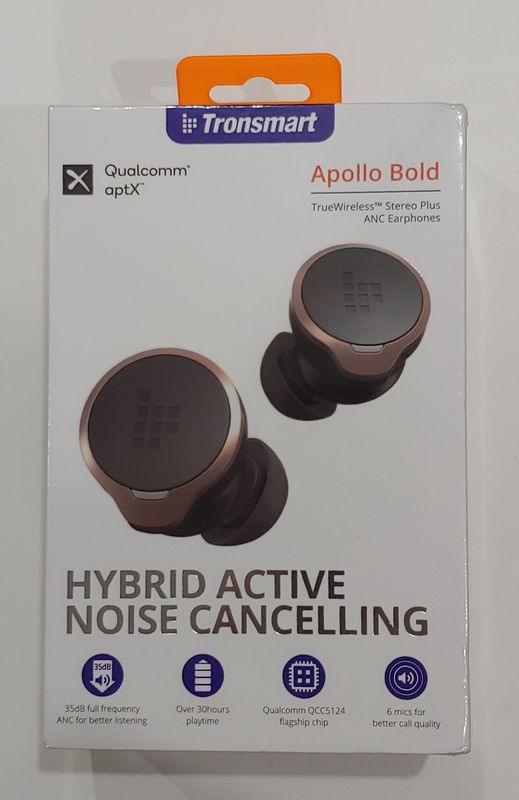
The earbuds come in a high-quality cardboard box with a magnetically closed fold-out cover. The front of the box depicts a glossy rendering of the earbuds on a matte white background. The side of the box shows an exploded view from the top-down and the inside shows an exploded view from the bottom up. The opposite side illustrates the three modes of noise reduction available. The rear lists the specifications and shows a rendering of the charging case.
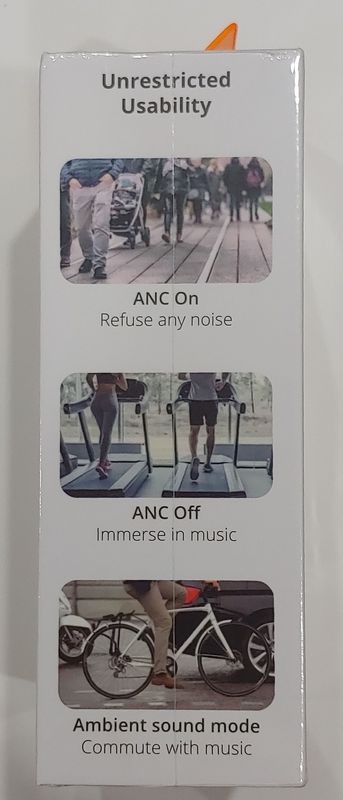
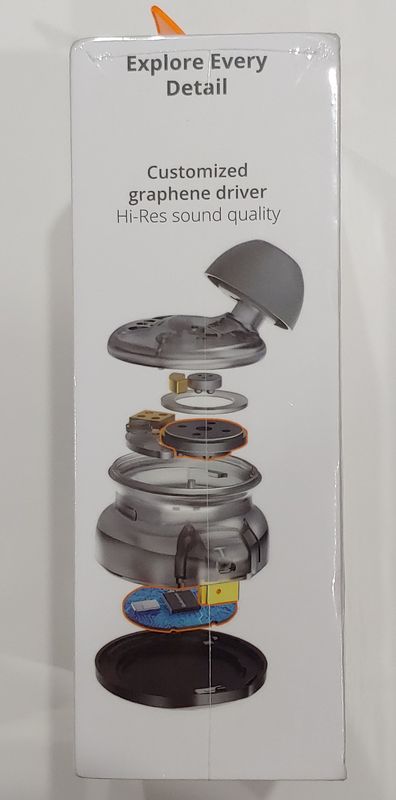
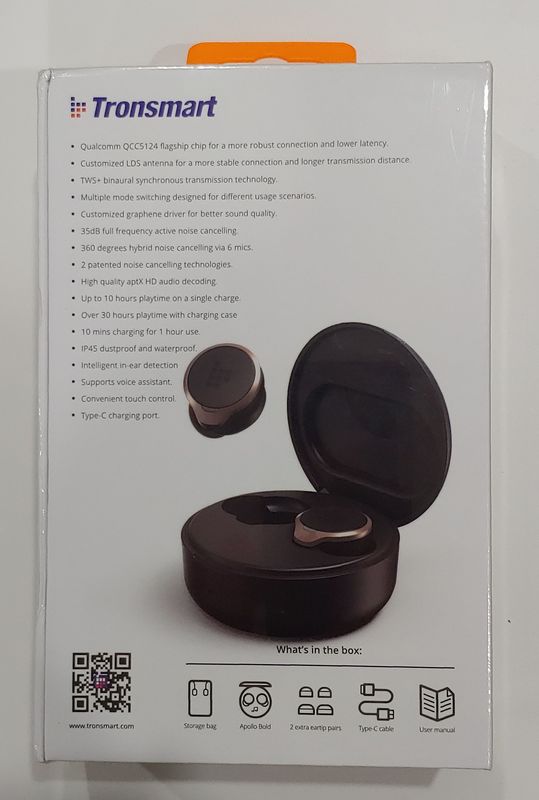
The earbuds are on full display through a clear plastic cover on the inside. Once the earbuds and charging case is removed, the manual, ear tips, and charging cable are available underneath the plastic tray. Still under that, packed like a veritable matryoshka doll set, is a carrying bag. The carrying bag may either be included to align with the items included in other similar earbuds, or could be a not-so-subtle clue that the charging case should be handled with care.
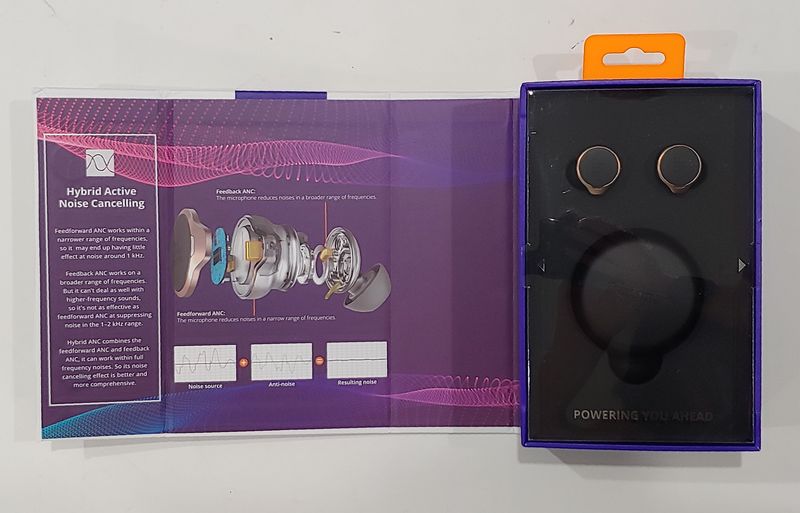
Design
The design of the earbuds is very similar to models sold by other manufacturers. While researching the Tronsmart Apollo Bold and the chip used within, I discovered that Cleer, Inc., released the ALLY Plus in January 2019 (for sale in Q1 2020). Also, the 233621 Zen ANC earbuds look very close to the Tronsmart. While the ALLY plus has a different style case, the 233621 and the Tronsmart share the same round case design. Given the timing of the press release and the comparison of the design with the Cleer ALLY, I’ll assume that Cleer was the original developer of the design used by Tronsmart. Because the Tronsmart case has an indentation at the front-center of the lid which is featured prominently on the 233621 case, I’ll assume that 233621 was the original developer of the case design used by Tronsmart.
The case is my least favorite part of the design. (I suppose it is better to have great earbuds and a poor case design than a great case for poor sounding earbuds.) While the case does merit appreciation for being small, there are a few concerning features and some which could use improvement. The case is a squat cylinder with a USB charging port in the rear and a small indentation opposite the hinge for opening the lid. The lid, on top of the cylinder, is held in place by two magnets on the front and is hinged in the rear above the USB port.
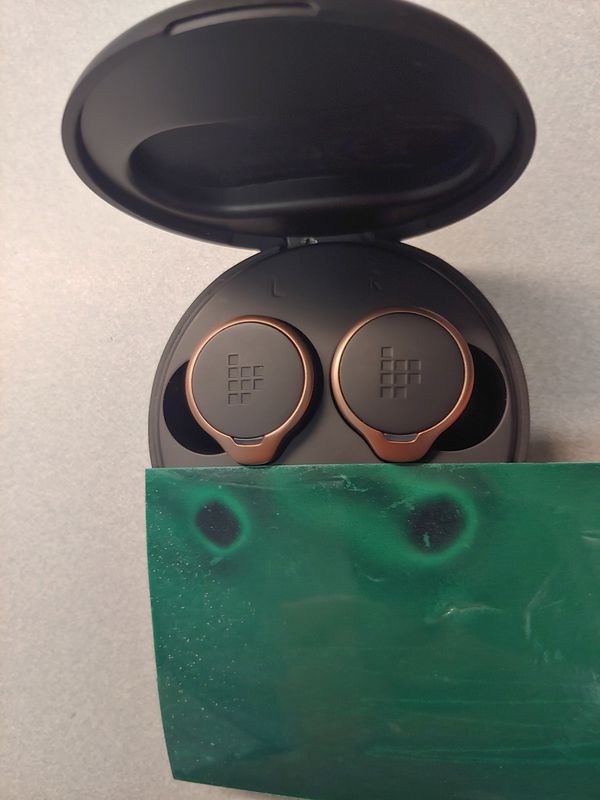
The green magnetically sensitive film shows the location of the magnets. A third magnet on the lid is used in combination with a hall sensor to determine if the lid is open or closed.
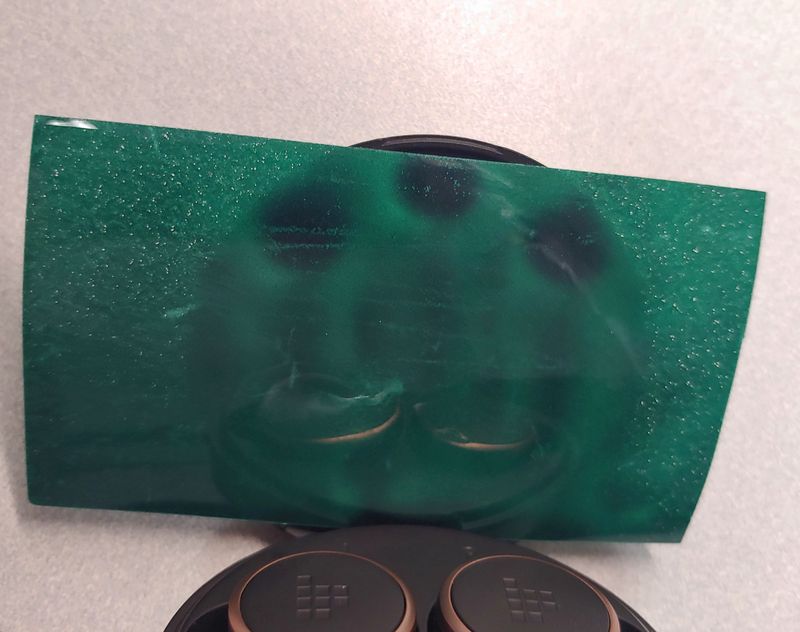
Because of the geometry of the design, it is very difficult to figure out where the opening of the lid is located, sight unseen. It seems that Tronsmart, in a bid to differentiate the design from 233621 by removing the depression on the top, removed one of the best ways to figure out how to open the case.
I can imagine that if the case is dropped with the lid open that it may break the hinge since the lid is big compared to the hinge and the whole assembly is made of plastic. The earbuds are held in place by magnets at the ear-facing side of the earbuds. I find it is a bit difficult to take the earbuds in and out of the case and have made it a habit of banging the open case against my hand to shake the earbuds out like the last gummy vitamin in the jar.
The only other feature on the case is the LED indicator. This is a solid red while charging and not lit when charging is complete. Opening or closing the lid will cause the LED to blink white if the case charge is above 10% or blink red if the case charge is below 10%. If the LED would glow a constant white for a charge above 66%, blink white for a charge above 33% and blink red for a charge below 33% then a user would know if there are 1, 2, or 3 full charges left. An array of LED lights or a greater number of colors could provide even more information. As it is, there is little information provided and I have once or twice discovered I have dead earbuds and a dead case because of the little information provided by the indicator. The easiest remedy for this is to charge the case every night. With 30 hours of reserve (at 50% volume) there is little chance that the battery will expire when you need it most.
The rear of the earbuds is a satin black plastic domed circle with the Tromsmart logo embossed on the surface. The circle is surrounded by a copper-colored ring. The lower quarter of the ring that points towards the mouth is extended and terminates with a microphone port. A status LED is between the inner circle and the microphone port extension. The LEDs slowly glow white while in use; other people will notice but it is not as bright or noticeable as the LEDs on the Edifier TWS NB, which look like the navigation lights on an aircraft. Overall the exterior is a very functional and slick looking design. The domed surface is actually a touch sensor used for registering touches and holds. The earbuds have voice prompts for power on, power off, ANC off, Ambient mode, ANC on, device not found and low power. The other interactions are either silent or by beeps, such as during connection, disconnection, low volume, or high volume. The antenna is mounted below the copper ring. and having it mounted away from the skull improves reception. There is another microphone port directly opposite the protruding one facing the mouth. I will guess that this is the feedforward microphone used for ANC.
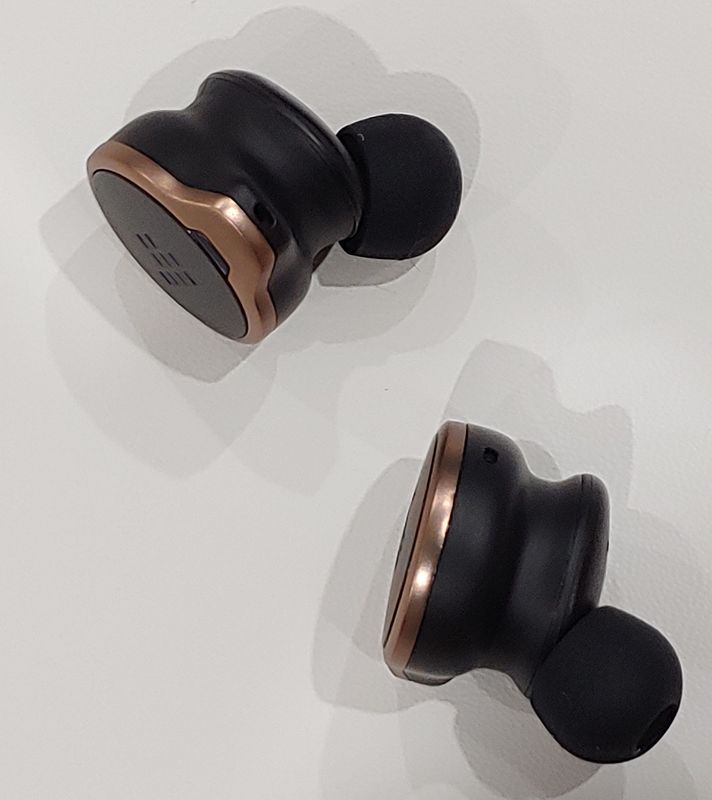
The middle of the earbud narrows so that it is held in place by the tragus and antitragus. The Tronsmart Apollo does not sit in the intertragal notch quite like the Jabra Elite series or original AirPods but it does seem to effortlessly stay in the ears. Because the fit isn’t relying solely on the fit in the canal they can be worn for extended periods. I took a 2 mile jog with them and they seemed fine the entire time but I was also not perspiring heavily and was probably lighter on my feet than usual (who would have thought that the fear of losing earbuds would make you a better runner?) However, I have have had the Apollos fall out while eating or laughing but this has always proceeded with the feeling that it is about to fall out. And if they fall in a puddle then they may or may not survive. They are rated to IP45 so that means water from a 1/4 inch jet should be ok, but I certainly wouldn’t try to get them wet. I’ll say that the comfort is above other TWS I have used and the staying power is about average to a little above average.
The outside, domed surface is about 5/16 inch or 8 mm above the center of the narrowed portion.
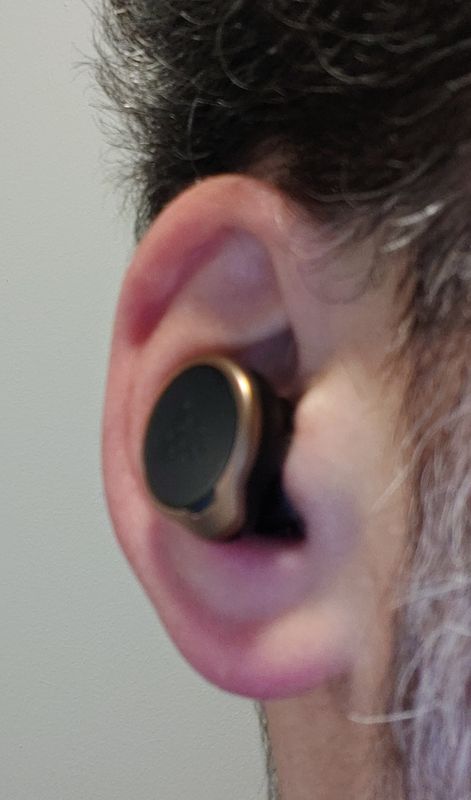
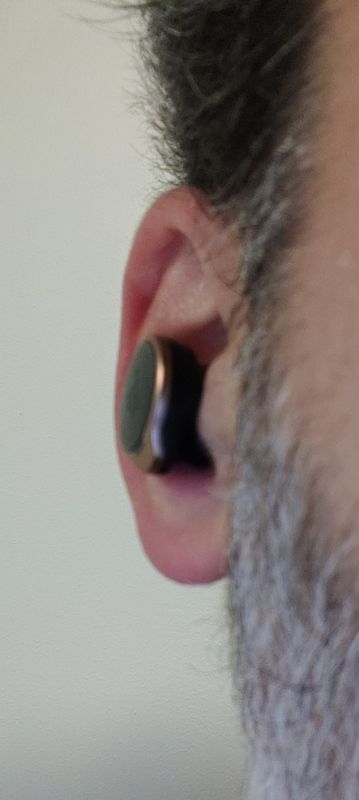
This is about half of the length that the Edifier TWS NB stick out of the ears. The ear-facing side of the earbud is about half a centimeter from the center of the narrowed portion. So the base of the earbud isn’t designed to rest against the concha but is more comfortably placed above it. This design contributes to the feeling that the earbud is floating inside your ear, not pushed up halfway to the brain stem. The base of the earbuds has four contacts, two ports, a sensor, a powerful magnet, and one very oblong post. 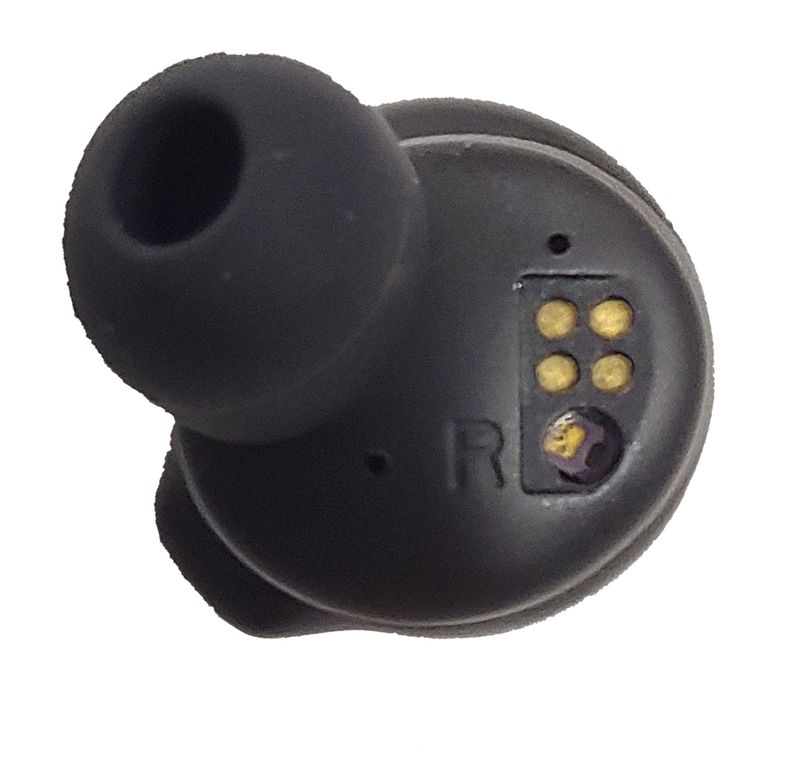 The charging contacts seem to have good retention in the case because of the pair of magnets in the case and in the earbud. The magnet on the earbud is sown as the dark spot on the green magnetically sensitive film.
The charging contacts seem to have good retention in the case because of the pair of magnets in the case and in the earbud. The magnet on the earbud is sown as the dark spot on the green magnetically sensitive film.

In fact, you can leave the top of the case open to see if the charging is complete. The holes on the base of the unit appear to be speaker ports to increase bass and volume; the internal components in the file here do not provide enough detail of the bottom of the earbud. The sensor on the bottom is used by the earbud to pause the music when the bud is removed from the ear. It is the same type of technology the Apple AirPods use and works quite well even in a completely dark closet. However, the sensor can be fooled into thinking the earbuds are being used if the sensor is covered with your finger.
The oblong post is unconventional but not the first of its kind.
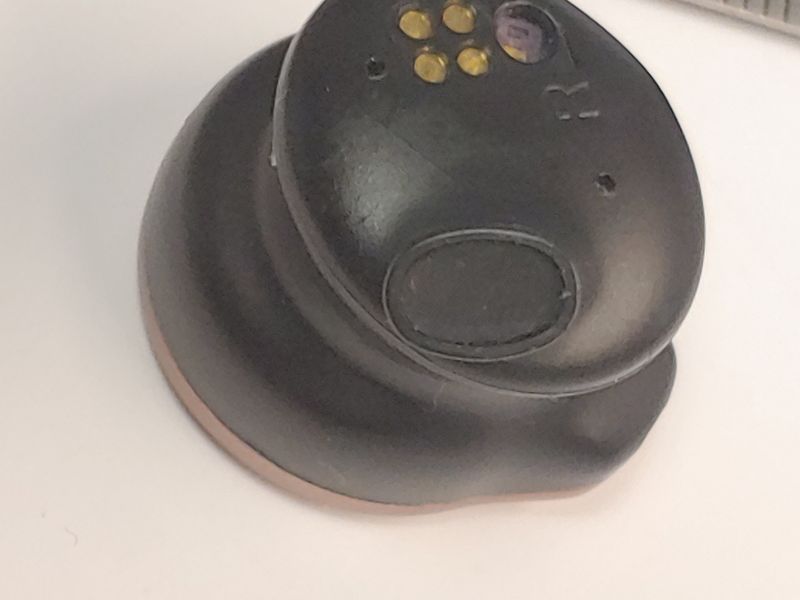
However, it is difficult, or perhaps impossible to find a replacement set of ear tips. The closest looking device I have seen that offers tips is the Nuheara IQbuds. I’m not sure that they would fit and Nuheara only sells 5 pairs of a particular size of tip, so the correct size needs to be known before ordering. I believe that the oval post is to aid in comfort and may also enable feedback ANC.
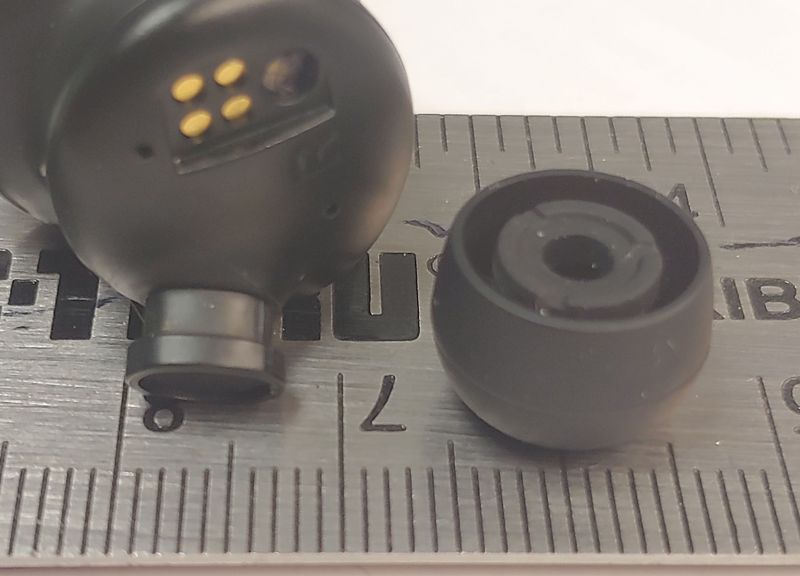
Tronsmart has promised to follow up with an app in September 2020 but as of this review, it has not been published. Tronsmart has an active presence on Head-Fi and they have surveyed what users there are looking for. The results of the survey may give some indication of what the app will be able to do.
Performance
The passive noise reduction is not as good as it would be with foam tips, but the silicone tips that come with the Tronsmart do an average job at blocking outside noise. The active noise canceling (ANC) is terrific and on par with the TaoTronics TT-BH046 Hybrid ANC wireless stereo headphones. It is really quite an accomplishment to have wireless erabuds perform at the same level as headphones. It all but eliminated to noise from an air conditioning condenser unit outside. There is a bit of a hissy artifact if the ANC is used in a quiet room but in that case, of course, ANC is not required. The ambient mode is just as impressive as the ANC. It is very easy to conduct a conversation with this mode on and it is also very sensitive to ambient noises as well for when these may be used during outdoor activities.
I found that the earbuds last from 3.5 to 10 hours depending on the ANC/ambient status and what level the source audio and internal volume are set to. With the volume about halfway down, I have enough charge time for morning meetings and afternoon meetings if I have about a one hour break to charge during the day. On the busiest day, I wore the Apollos for about 7 hours during the day and my ears felt fine and the battery was only charged for about 70 minutes in the middle of the day. The earbuds will give a good hour of ANC performance with only 10 minutes of charge from the “low power” warning. Charging the depleted charger took 70 minutes to charge 350 mAh with a 2 Watt draw.
The listening experience with the Tronsmart Apollo emphasizes warm tones and is bass-heavy. Because of the tone of the earbuds, classical flutes and cymbals still come through, and even at high volumes do not suffer from sibilance or brightness. The highs are a bit subdued but still clear. Also, if the ear tips don’t seal all the way the heavy bass will still come through. The Tornsamrt app will hopefully permit better control of the in-ear amp but for now, I’ve measured 16 steps between minimum and maximum volume, so hitting a limit and then adjusting the volume 8 steps in the other direction gets to about the 50% volume mark. If the in-ear volume is all the way up then there can be some crackle and clipping on bass-heavy songs.
Pairing the Tronsmart is interesting. The earbuds will pair with the device using one bud or another, and after that is paired the other device will also pair. I’ve renamed the paired items Tronsmart Left and Tronsmart Right. When using the stereo earbuds there is still a master and slave relationship between the two devices. If the left is the master and it is put in the charger then the right will pair and pick up where the left stopped playing. In this situation, there may be a temporary disconnection. If the left is the master and the right is put in the charger then there is a bumpless transfer to monaural use. The connection between a computer or a phone is fantastic. The Bluetooth held up much greater than 50 feet in an office building and about 50 ft in a household. The Tronsmart Apollo Bold has very low latency when playing back movies on a device and when used with videoconference.
The Qualcomm cVc reduces background noise as well as it does on many other devices. Using the Apollos with the ambient mode on during calls illuminates the occlusion effect that makes it sound like your talking into a pillow on other earphones
What I like
- Good sound
- Great ANC
- Secure placement
- Comfortable fit
What I’d change
- A more robust case with a better indication
- more control over the LEDs, EQ and touch controls (that hopefully come with the app)
Final thoughts
The idea of TWS is based on freedom from wires. Originally this freedom came with the cost of poor audio quality and a spotty connection. The Tronsmart Apollo Bold has excellent connectivity and excellent audio quality, even if it isn’t entirely authentic. With the Tronsmart Apollo Bold, you can get freedom from ambient noise, freedom from having to remove an earbud if you want to talk to someone, or if you do, then freedom from having to stop your music. The Apollos also gives you the freedom to choose which earbud to pull out of your head and which earbud to leave in place. They also give you freedom from having to constantly charge the earbuds. Considering that all this freedom comes at the $100 price point, I think this freedom is worth every cent.
Price: $99.99
Where to buy: Amazon
Source: The sample of this product was provided by Tronsmart.


